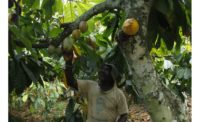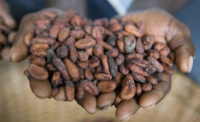As the World Health Organization’s constitution asserts, ensuring the highest attainable standard of health is a “fundamental right of every human being.” That right, however, becomes even more difficult to attain if the right infrastructure isn’t there.
The Hershey Co., in partnership with cocoa suppliers Blommer Chocolate and Olam Cocoa, looks to do its part for cocoa farmers in Cote d’Ivoire. The trio has funded and built a community health center in the town of Teapleau, which is on the country’s western side. The recently opened health center is part of the Hershey Learn to Grow training and cocoa sustainability program that seeks to improve the lives of cocoa farmers and communities in West Africa.
The new health center now provides basic health services, such as: maternity facilities; lab testing for AIDS and malaria; and vaccinations for polio, tetanus and measles to 1,700 households and 13,000 people across three area communities. Without the center, families in this cocoa farming community would have to either forego treatment or travel long distances for care.
“Our programs go beyond helping farmers learn how to grow quality, sustainable cocoa,” says Terry O’Day, senior v.p. and chief supply chain officer. “We work with our partners to improve the wellbeing of all families through education and development projects that benefit everyone in the community.”
As Kip Walk, Blommer Chocolate Co.’s corporate director of sustainability, explains, “In addition to the support of the individual farm, providing the opportunities necessary to help build thriving communities is critical to the long-term success of the farming sector. We share Hershey’s vision of benefiting thousands of lives.”
Cocoa farmers around the town of Teapleau are part of the CARET Cocoa Cooperative and have been part of the Hershey Learn to Grow program for two years. In partnership with the local community and CARET Cooperative, Hershey, Blommer and Olam Cocoa built the health center based on the community needs as determined by the community members. "We're all very happy about this facility. We're very thankful," says local cocoa farmer Jean François Yomi.
The health center project was coordinated with the Ivorian government and the government will manage the staffing and long-term management of the facility.
In December, Hershey representatives placed the corner stone of a second health center scheduled for construction in 2016. This second center will be located outside the city of Man in the village of Siambly. This facility is expected to provide access to health services to 3,000 families or nearly 24,000 people in six communities.
Hershey Achieves 2015 Certified and Sustainable Cocoa Goal, Sets New Target for 2017
Separately, Hershey confirmed that it had achieved its goal to source 50 percent of its global cocoa supply from certified and sustainable sources by the end of 2015, a full year ahead of its original schedule. Given this accelerated progress, the company has set a new target of sourcing 75 percent of its global cocoa supply from certified and sustainable sources by the end of 2017. Hershey has committed to source 100 percent certified and sustainable cocoa by 2020.
Last year, Hershey announced that reaching this important responsible sourcing milestone would enable the company to source enough certified and sustainable cocoa in 2016 to surpass the amount of cocoa required, on a mass balance basis, for the global production of four of its most popular chocolate brands: Hershey’s, Kisses, Kit Kat (United States only) and Brookside. In addition, Hershey pledged that it will add the global Reese’s brand, the company’s largest brand, and others to these four brands in 2017.





